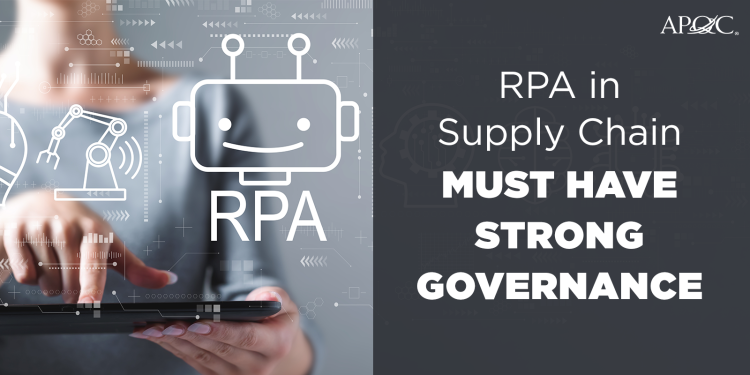
Robotic Process Automation (RPA) is often positioned as a game-changing technology that helps organizations achieve cost savings, better process performance, and numerous other benefits. But given all the hype around automation, it’s all too easy to underestimate the amount of time, labor, and other resources that it takes to implement RPA effectively. After sharing data on the prevalence of RPA in supply chain, this APQC Resource Library article describes several foundational elements that need to be in place for RPA to deliver value to the organizations that adopt it.
Deciding to adopt RPA for supply chain is the easy part. Governance is critical to ensure that someone is accountable for automated processes, that automation is performing as it should, and that the right controls are in place. Governance models for RPA tend to take one of three forms:
- Centralized: A core team or a center of excellence (COE) is responsible for establishing RPA standards and providing guidance across all business units.
- Decentralized: Independent teams or COEs govern RPA and provide support within each business unit.
- Hybrid: A centralized RPA team provides support for RPA teams or business unit COEs across the enterprise.
It is important to note that these structures are not set in stone—organizations can and often do change RPA governance structures over time. When RPA is first introduced, it makes sense to have a centralized governance model with a core team or COE who can get RPA up and running. As team members across an enterprise build RPA skills, the organization can move to a hybrid model in which a central COE provides resources and guidance to RPA partners who are embedded in the business. Some organizations eventually move to a decentralized model in which independent RPA COEs or teams provide governance for their respective areas.
Common Roles and Responsibilities for RPA
Effective automation requires team members who can carry out the following roles and responsibilities, both on the technical side and the business side of RPA:
- RPA Sponsor: Initiates the idea of automation, underwrites resources, and protects progress into business adoption.
- RPA Project Manager: Forms the RPA team to build the setup and deliver the program across business units. Manages the RPA team and the business stakeholders to achieve the expected automation results.
- RPA Change Manager: Creates a change and communications plan aligned to project deliverables in order to ease RPA adoption within the organization.
- RPA Infrastructure Engineer: Handles server installations and troubleshooting.
- RPA Solution Architect: Defines the architecture of the RPA solution and is the guardian of the overall performance of the agreed-upon solution.
- RPA Service Support: Provides first-line support for the RPA solution deployed.
- RPA Developer: Designs, develops, and tests the automation artifacts.
- RPA Business Analyst: Creates the process definitions and process maps used for automation.
There does not need to be one team member for each of these roles—all of them could in theory be carried out by just a few team members if needed.
To continue the conversation follow Marisa on Twitter at @MB_APQC, or connect with her on LinkedIn.